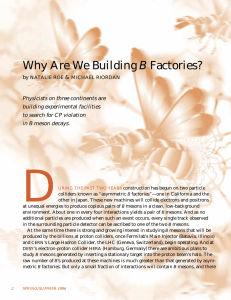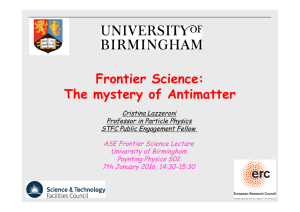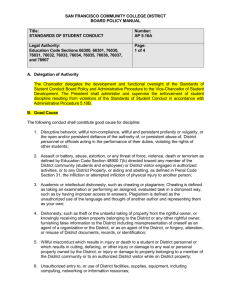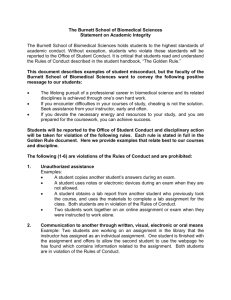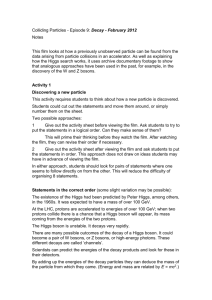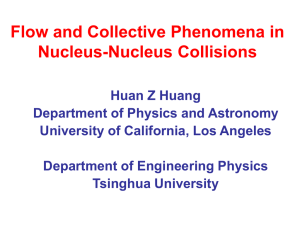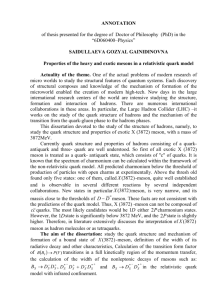Explaining matter/antimatter asymmetries
advertisement
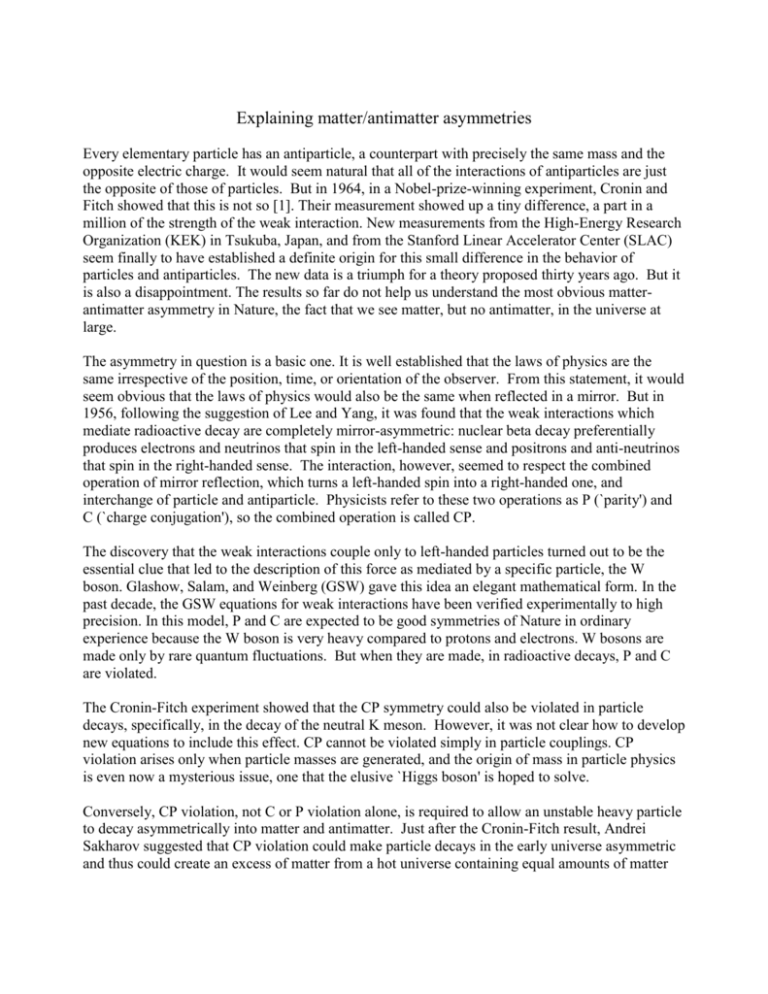
Explaining matter/antimatter asymmetries Every elementary particle has an antiparticle, a counterpart with precisely the same mass and the opposite electric charge. It would seem natural that all of the interactions of antiparticles are just the opposite of those of particles. But in 1964, in a Nobel-prize-winning experiment, Cronin and Fitch showed that this is not so [1]. Their measurement showed up a tiny difference, a part in a million of the strength of the weak interaction. New measurements from the High-Energy Research Organization (KEK) in Tsukuba, Japan, and from the Stanford Linear Accelerator Center (SLAC) seem finally to have established a definite origin for this small difference in the behavior of particles and antiparticles. The new data is a triumph for a theory proposed thirty years ago. But it is also a disappointment. The results so far do not help us understand the most obvious matterantimatter asymmetry in Nature, the fact that we see matter, but no antimatter, in the universe at large. The asymmetry in question is a basic one. It is well established that the laws of physics are the same irrespective of the position, time, or orientation of the observer. From this statement, it would seem obvious that the laws of physics would also be the same when reflected in a mirror. But in 1956, following the suggestion of Lee and Yang, it was found that the weak interactions which mediate radioactive decay are completely mirror-asymmetric: nuclear beta decay preferentially produces electrons and neutrinos that spin in the left-handed sense and positrons and anti-neutrinos that spin in the right-handed sense. The interaction, however, seemed to respect the combined operation of mirror reflection, which turns a left-handed spin into a right-handed one, and interchange of particle and antiparticle. Physicists refer to these two operations as P (`parity') and C (`charge conjugation'), so the combined operation is called CP. The discovery that the weak interactions couple only to left-handed particles turned out to be the essential clue that led to the description of this force as mediated by a specific particle, the W boson. Glashow, Salam, and Weinberg (GSW) gave this idea an elegant mathematical form. In the past decade, the GSW equations for weak interactions have been verified experimentally to high precision. In this model, P and C are expected to be good symmetries of Nature in ordinary experience because the W boson is very heavy compared to protons and electrons. W bosons are made only by rare quantum fluctuations. But when they are made, in radioactive decays, P and C are violated. The Cronin-Fitch experiment showed that the CP symmetry could also be violated in particle decays, specifically, in the decay of the neutral K meson. However, it was not clear how to develop new equations to include this effect. CP cannot be violated simply in particle couplings. CP violation arises only when particle masses are generated, and the origin of mass in particle physics is even now a mysterious issue, one that the elusive `Higgs boson' is hoped to solve. Conversely, CP violation, not C or P violation alone, is required to allow an unstable heavy particle to decay asymmetrically into matter and antimatter. Just after the Cronin-Fitch result, Andrei Sakharov suggested that CP violation could make particle decays in the early universe asymmetric and thus could create an excess of matter from a hot universe containing equal amounts of matter and antimatter [2]. In principle, a universe with equal amounts of matter and antimatter could separate into regions with matter or antimatter excesses. But the antimatter must end up somewhere, and at the interfaces electrons and positrons should annihilate to gamma rays. These annihilation gammas are not observed. So it is a very attractive idea that the present universe contains only matter, as the result of a CP asymmetry in the fundamental laws. To evaluate this idea, we need to know the origin of CP violation. CP violation originates in expressions for particle masses. In quantum mechanics, a massive particle is a quantum state, which may be a mixture of some more basic states. CP violation results from such mixing, when the mixing amplitudes are complex numbers with different phases. But which specific particles give the CP violation that we observe? These might be heavy quarks, or Higgs bosons, or completely new species such as the supersymmetric particles predicted by string theory or the ultraheavy leptons responsible for neutrino masses. In 1972, when the GWS model of weak interactions was still a speculation and even quarks were considered with skepticism, Makoto Kobayashi and Toshihide Maskawa put forward the idea that CP violation originates in the mass mixing of heavy quarks [3]. Quarks were expected to have mass mixing; Cabibbo had shown that this idea gives the correct rates of K meson weak decays [4]. At that time, though, only three species of quarks were known, and all three had small masses. Kobayashi and Maskawa (KM) asked for more quarks, six in all, to build a theory with intrinsic phase differences in the mixing terms. It was a wild idea. But, wild or not, these heavy quarks have turned up in experiments. The sixth quark, the top quark, which is almost 200 times heavier than the proton, was discovered at the Fermi National Accelerator Laboratory in 1995. If heavy quarks are needed for CP violation, it is logical that the decays of heavy quarks would show much larger CP asymmetries. Bigi, Carter, and Sanda proposed that one could see this in the decay of a B meson, a particle that contains the heavy b quark together with a light quark, and specifically in the decay B K0 [5]. This decay can occur by two different paths, as shown in Fig. 1; either the B can convert directly to K0, or it can convert to its antiparticle B , which then turns to K0. In quantum mechanics, when a reaction occurs by two different paths, interference effects can occur. In this well-chosen reaction, the relative phase of the interfering terms is precisely the CP-violating phase of the KM model. If CP violation is fundamentally a large effect, the phase angle should be large. The experimental requirements are challenging. This particular decay can be observed in only one of a hundred thousand B decays, requiring huge numbers of high-energy collisions and unprecedented accelerator performance. The interference appears in the time-dependence of B decays. Oddone had the idea to create B mesons in motion, in asymmetric electron-positron collisions, to allow the interference to unfold in space, but the B meson still travels only a few hundred microns before decaying, requiring precision silicon tracking devices. New accelerators were built at KEK and SLAC to meet these needs. These accelerators—KEKB and PEP-II—have been operating for three years. They now hold all of the performance records for colliding-beam particle accelerators and have produced a total of 300 million B decays. At this summer's International Conference of High Energy Physics in Amsterdam, the BaBar and Belle experimental groups from SLAC and KEK presented the results on the KM angle that they have derived from this data [6]. The KM theory has two free parameters. One is the CP-violating phase angle. The other can be fixed by measuring the probability for the b quark to decay to a lighter u quark rather than a heavier c quark. The overlap of the orange and red bands in Fig. 2(a) shows the parameter determination from these two measurements. The blue band in this plot shows the parameter values that give the correct amount of CP violation in neutral K meson decays to account for the results of Cronin and Fitch and their successors. To the current level of accuracy, the KM theory nicely explains their effect. In the next few years, these measurements of B decay will be sharpened and new measurements from BaBar, Belle, and the experiments at the Fermilab Tevatron will come into play. Some possible future constraints on the KM parameters are sketched in Fig. 2(b). For the KM theory to be correct, all of these constraints must pass through a common point in the parameter space. Curiously, the first Belle and BaBar results on the decay B K, also presented in Amsterdam, show the opposite sign of the interference from that predicted by the KM theory. There is much at stake. Despite many attempts, no one has been able to use the KM model of CP violation to create the matter excess of the universe through Sakharov's mechanism. Only a small asymmetry is needed in the early universe, since today we have only one leftover proton for each billion photons. But simple calculations in the KM model give a prediction of 1 in 1018, and no cosmological model has been found that improves this by more than a few orders of magnitude. The problem is that CP violation in the KM model requires not only the heavy quark but also the light quark masses, and these latter terms are unimportant at the high temperatures of the early universe [8]. Models of CP violation that involve heavy objects only, for example, models with additional CP-violating phases in the mass mixing of Higgs or supersymmetry particles, can readily account for the observed excess of protons. Unless the new particles are extremely heavy, their CP effects should also show up in B decays. If these particles are present, the precise B decay experiments of the next few years should show anomalies, perhaps qualitative differences from the KM predictions, perhaps 10-20% discrepancies that the KM model cannot account for. At this moment, no one knows what the result will be. Later in the decade, when we produce millions of top quarks and other exotic particles at the LHC at CERN, we will have an opportunity to search directly for CP violation associated with these heavy states. For the moment, Kobayashi and Maskawa appear triumphant. Their 1972 model of heavy quarks appears to explain all of the CP violation seen today in particle physics experiments. If it cannot also explain the universe, that is a task for stranger particles that still await discovery. References: 1. J.H. Christenson, J.W. Cronin, V.L. Fitch and R. Turlay, Phys. Rev. Lett. 13, 138 (1964). 2. A. D. Sakharov, JETP Lett. 5, 24 (1967). 3. M. Kobayashi and T. Maskawa, Prog. Theor. Phys. 49, 652 (1973). 4. N. Cabibbo, Phys. Rev. Lett. 10, 531 (1963); S.L. Glashow, J. Iliopoulos, L. Maiani, Phys. Rev. D2, 1285 (1970). 5. A. B. Carter and A. I. Sanda, Phys. Rev. D23, 1567 (1981); I. I. Bigi and A. I. Sanda, Nucl. Phys. B193, 85 (1981). 6. BaBar Collaboration (B. Aubert et al.), hep-ex/0207042; BELLE Collaboration (K. Abe et al.), hep-ex/0207098. 7. A. Höcker, H. Lacker, S. Laplace, and F. LeDiberder, Eur. Phys. J. C21, 225 (2001). 8. P. Huet and E. Sather, Phys. Rev. D51, 379 (1995). Figure Captions: Fig. 1: Quantum processes whose interference measures the CP-violating parameter of the Kobayashi-Maskawa theory. Fig. 2: Present and future of CP violation measurements: (a) The parameter determinations from measurements of the probability of b quark decay to a u quark (red) and from the new BaBar and Belle interference measurements (orange), compared to the parameter region needed to explain the magnitude of CP violation in K meson decays (courtesy of A. Höcker; see Ref. [7]). (b) Future parameter determinations expected from more detailed measurements of B meson decays. If the KM theory is correct, all of the bands must meet at some point in the plane. If the results are as shown, there must be new heavy particles contributing to CP violation.



